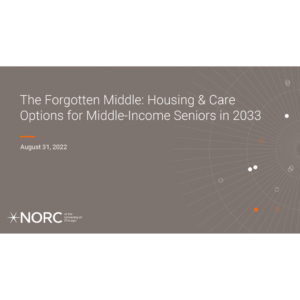

The study, which was recently updated in August 2022, focuses on key details about the population of middle-income seniors (age 75+), including demographic, health, cognitive and functional health, and financial details. It updates the analysis of the original study, including more of the baby boom generation, reflecting the changes in the population size as well as the changes in seniors’ financial investment performance.
Key Findings From the 2022 “Forgotten Middle” Study
The report’s findings highlight the growing population that will need some sort of senior care, as well as the challenges that the population will face in accessing that care. According to the report, the population of middle-income seniors will nearly double in the coming decade, reaching 16 million by 2033. A majority of those seniors will be unmarried by 2033, and since many do not have children living nearby, they may rely on paid caregiving.
The report also highlights the fact that many seniors will face challenges in paying for the care they need. According to the report, 75% of middle-income seniors, or 11.5 million seniors, lack sufficient funds to pay for private assisted living, unless they sell their homes. Many see their home as being a “nest egg” that they can rely on during an emergency, and many want to be able to leave their home to their children. Despite having home equity 39%, or six million seniors, cannot pay for assisted living.
Considerations for Senior Care Organization Planning and Marketing
The report contains key information that is valuable for senior care organization planning and marketing.
Size of Population in Need
With the middle-income senior population set to reach 16 million by 2033, it’s evident that demand for care will increase substantially over the coming decade. This growing population likely indicates the need for not only home care, but also assisted living, memory care, nursing home services, and more.
Financial Limitations
Seeing as many middle-income seniors have limited financial resources, there is likely to be high demand for more affordable care from this population. Senior care organizations who are marketing to middle-income seniors should understand that, to afford a residential care setting, many seniors will have to sell their homes. Understanding their emotional attachment and reluctance to sell will be key when communicating with this audience.
Population Diversity
The senior population is becoming more ethnically and racially diverse. By 2033, 78% of the middle-income senior population will be white, 8% will be Black, and 10% will be Hispanic. High-income seniors will also become more diverse, with 89% of the population being white, 5% being Black, and 4% being Hispanic. Incorporating this diversity not only in marketing, but within the senior care organization, itself, is essential.
Health Needs
By 2033, 54% of middle-income seniors age 75 and up will have three or more chronic conditions, and 56% will have mobility limitations. Of middle-income seniors age 85 and up, 55% will have three or more chronic conditions, and 68% will have mobility limitations. The growing population will need increasing amounts of care, and seeing as the majority do not live near their children, many will need residential care situations.
Looking Forward
Whether planning program offerings, expansions, new business openings, or marketing strategies, the information in this report is highly valuable to the senior care industry. The middle-income senior population will rely on many residential services, and businesses that don’t yet focus on this population may want to incorporate middle-income seniors into their focus.




